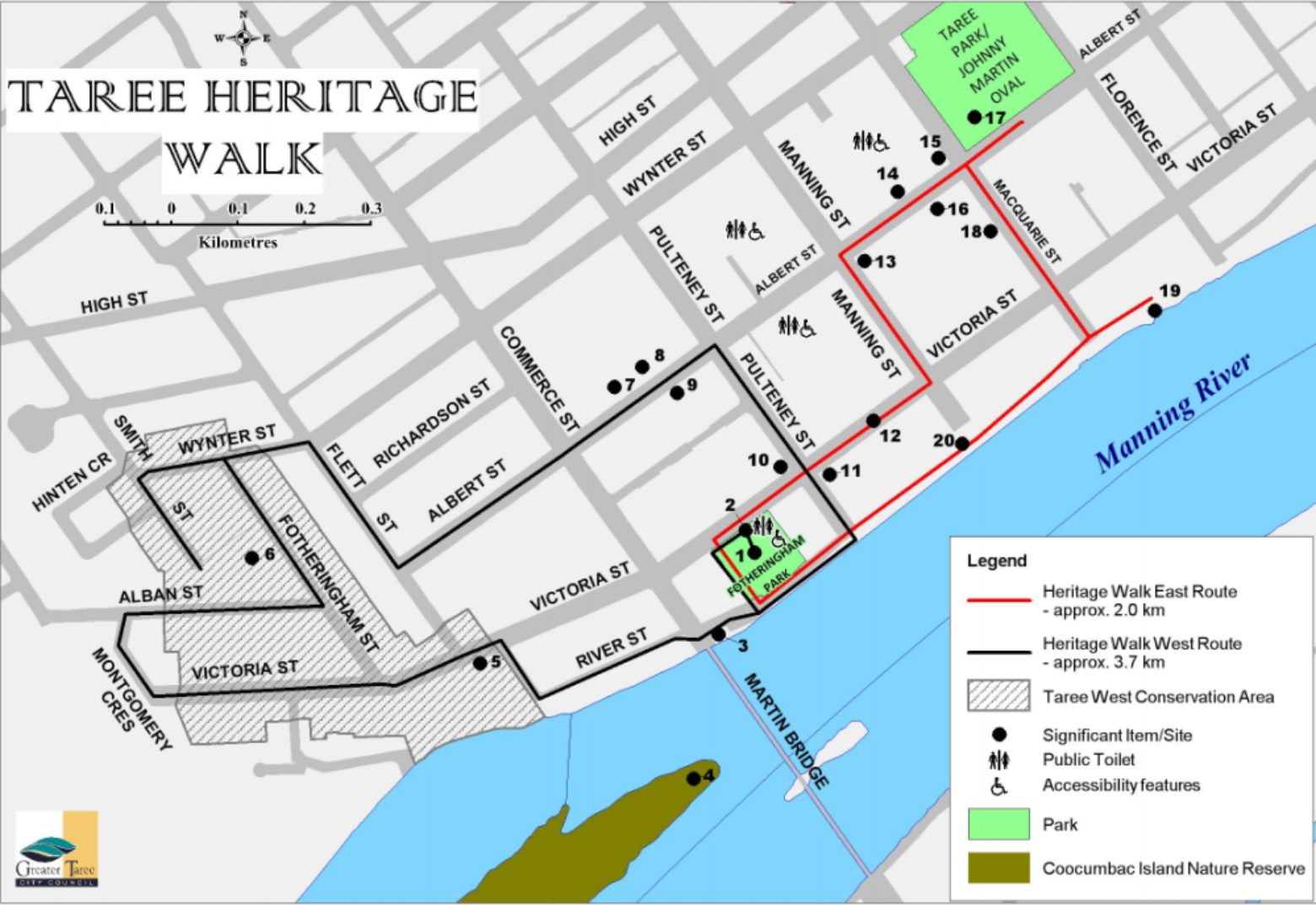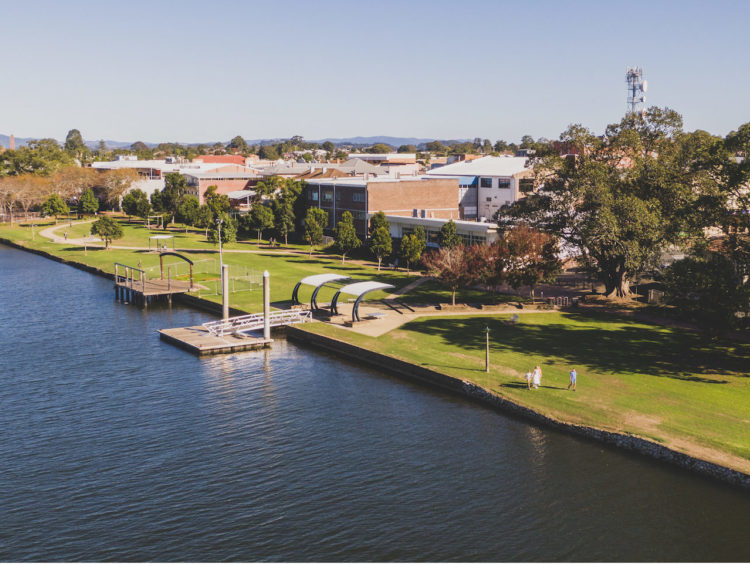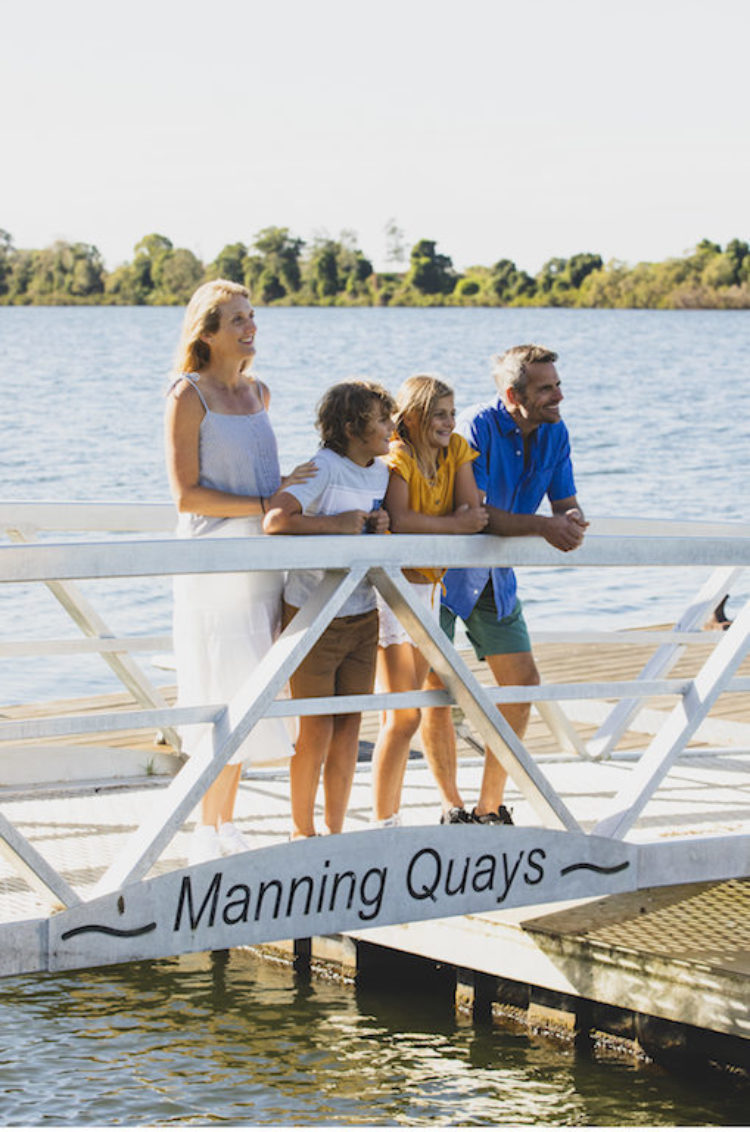Take a walk though Taree's history on the western walk and eastern walk.
Here are two easy walking itineraries around the riverside city of Taree. Combining both you'll uncover 20 places of historic interest, all of which are within two blocks of the broad Manning River.
The total walk is 5.7 km and takes around 2.5 hours depending how much you dawdle. But take your time and make sure you stop often to enjoy the vistas and streetscapes of this town built on the commercial strength of the Manning River.

The Western Walk
This walk begins and ends at Fotheringham Park. The walk features the Manning River, Taree West Conservation Area, churches and public buildings. Upon leaving Fotheringham Park the walk heads west along the Manning River and takes approximately 1.5 hours.
1. Fotheringham Park
This civic park was developed in the line of Mill Creek and provides shade and views to the river.
2. War Memorial Clock, Victoria Street
The War Memorial Clock is an art deco influenced sandstone clock tower built in 1925 as a memorial to the first World War. It was originally located at the Victoria and Manning Street intersection and was moved to the current location in Fotheringham Park to allow for the roadway improvements.
3. The ‘Tarree’ & wharf, River Street & Martin Bridge
The big ‘Tarree’ was the first ship built on this spot in 1834 by William Wynter. The site of the original wharf has been commemorated with a bicentennial plaque near the Martin Bridge. Bridge construction commenced in 1938 and the bridge opened in 1940, replacing river punts at Taree and Tinonee. The bridge was named after the Minister for Roads and its opening represented a major change in road transport for Taree.
4. Coocumbac Island from the foreshore
The island is a National Parks Reserve and consists primarily of lowland floodplain rainforest, an endangered ecological community under the Threatened Species Conservation Act. While this vegetation community was once extensive in the region, it now covers less than 100 ha in NSW, with Wingham Brush and Coocumbac Island Nature Reserves, two of the few remaining remnants on the Mid North Coast.
5. St Johns Anglican Church, Victoria St
The church was built in 1958. The hall was built in 1924. This is the city’s most significant landmark. The blue cross can be seen at night on the skyline across Taree.
6. Taree West Conservation Area
These streets contain fine collections of Victorian, Federation and California Bungalow houses. They are typical of those that give Taree its distinctive character. The houses show the characteristic use of timber and corrugated iron.
7. Law Courts, Albert Street
1882, built in Victorian/Italianate style is the most significant public building in the city. The brick building features three large arches and a wide verandah.
8. Catholic Church group, Albert Street
Built in 1930 to replace the earlier 1870’s church, which exists behind. The presbytery was built in 1890 and has a verandah and balcony on four sides.
9. St Pauls Church, Albert Street
Built in 1869 in Victorian Gothic revival style, this is the oldest remaining church and oldest building in Taree.
10. Former AMP Building, Pulteney Street
Constructed in 1929, this building exemplifies small commercial buildings of the time. Significant detailing includes the parapet with naming panels and original shopfronts. This building is the winner of the 2008 Heritage Awards
11. Beehive Store
Built in 1907. The first department store in Taree, and the second building on the site. The building is a Federation Free Classical Style reflecting society’s growing prosperity.

The Eastern Walk
This walk begins and ends at Fotheringham Park. The walk commences with items 1,2,10 and 11 of the Western walk then continues east on Victoria Street (no 12) and features commercial buildings, parks and the river front. This walk takes approximately 1 hour.
12. Victoria Street
The main shopping street of Taree has undergone many changes. It is proposed to restore many remaining old buildings, with colour schemes and verandahs.
13. Manning River Times Office
This simple Victorian commercial building was built in 1899, the Manning River Times was founded by James Boyce. The Manning River Times commenced in 1869.
14. Uniting Church
One of the four small late 19th century built churches remaining in Taree. Built in 1881 in the Gothic Revival style, along with the former Minister’s residence opposite at 12 Albert Street.
15. Boyce House
A brick Victorian Style House, 1891. This is one of the few early brick houses left in the city.
16. Taree Public School
This group of buildings dates from 1898 and demonstrates a development of Federation and Victorian styles.
17. Taree Park
This is an important open space within Taree and contains a number of heritage listed items, including the memorial gates, grandstand and street tree plantings of camphor laurel and the Croquet Club.
18. Headmaster’s Residence, Macquarie St
Federation style brick bungalow which is now used as Manning Regional Art Gallery.
19. Wreck of the Manning
This wreck at the end of Macquarie Street is all that remains of a small paddle wheel steamer operated by the North Coast Steam Navigation Co. It was constructed in Sydney in 1878 and operated for 59 years.
20. Queen Elizabeth Park
Is a restful walkway along the Manning River shaded by jacaranda and fig trees, which will bring you back to your starting point at Fotheringham Park.
